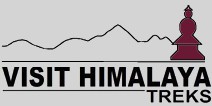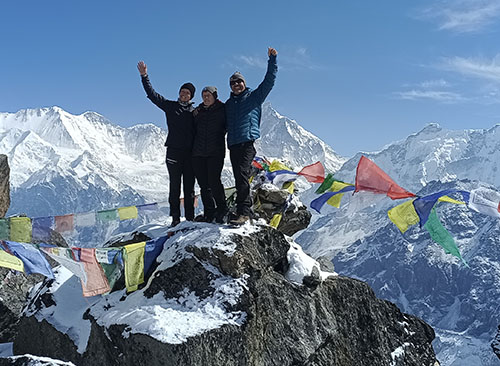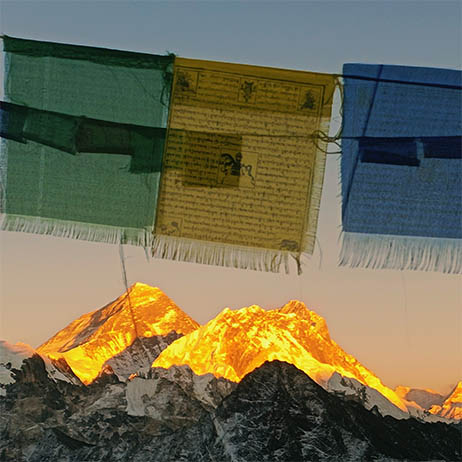Nar Phu Valley Trek ‘remote and high country truly a pure wilderness amidst picturesque location’ Annapurna region of Nepal.
Nar Phu Valley Trekking leads to a remote location above and beyond the popular and famous Annapurna Circuit trail. The route to Nar Phu diverts away from the main trail of Manang Valley and the Annapurna Circuit route.
The Nar Phu Valley Trekking is located in a hidden high country, a newly discovered Himalayan Shangri-La of Nepal Mid-West Himalayas. The area of Upper Manang around Nar Phu remains untouched and unspoiled as it was closed to the outside world. It was opened to travel in 2003, where few groups of trekkers seldom venture, as it falls within Restricted Areas. Requires a special permit to enter the former forbidden country of Nar Phu.
This wild highland remains a pristine wilderness, making the treks to Nar Phu special and exclusive. Adventure that leads to the wild areas and a perfect habitat for the elusive snow leopards and blue sheep. As well as for other mountain wildlife, often seen on walks to Nar and Phu. The charm and beauty of Nar Phu are the local native impressive cultures similar to their Tibetan predecessors. The age-old traditions and cultural heritage remain the as it they were for the past hundreds of centuries.
Nar Phu Valley Trekking is a combination with Annapurna Circuit after visiting the isolated and remote Nar Phu Villages. Then heads towards the high Kang-La Pass to join on the main route of Annapurna Circuit. The adventure to Nar Phu involves two high passes to cross Kang-La Pass (5320 meters) and Thorong La Pass (5416 meters) to reach the lower Mustang. En route to Kaligandaki River Valley around Muktinath, Kagbeni, and Jomsom town to complete the trip.

Old Traditional Local Village Phu.
How long does it take to trek to Nar Phu Valley?
Depends on the itinerary planned for private groups with customized or tailor-made itineraries. Most itinerary days include two passes with Kang-La and Thorang-La passes, to reach Jomsom town in Mustang. The general standard itinerary is 19 nights and 20 days with drives and flights from Jomsom to Pokhara.
Trekkers can make the trip shorter for a few days omitting the Thorang-La Pass, after crossing Kang-La to lower Manang Valley. Then drive back to Kathmandu or Pokhara via the same motorable road via Chame and Bhesisar towns. The other option is walking back on the same route, after visiting Phu and Nar villages back to Kodo village. Then driving back to Kathmandu or Pokhara which shortens the trek for more than 1 week.
Is Nar Phu Valley a difficult trek?
Nar Phu Valley is not as difficult as it looks with the nature of dramatic landscapes and terrains. The only hardest walk is climbing up to Kang-La Pass with a long descent to Ngawal village. As well climb to Thorang-La Pass of steep uphill, by then trekkers will be acclimatized. After visiting the high Nar Phu Valley, trekkers should know and must be aware of all Himalayan countries.
Is full of ups and downhill, as the saying ‘No Pain No Gain’. The higher you reach rewards you with the best views of the surrounding scenery. Makes you feel great about achieving the goal and highlights completing the treks to Nar Phu Valley.
As long one is physically fit and in sound health, walking at a slow pace takes a short rest on a steep uphill. Will overcome the difficulty and feel glad enjoying the beautiful treks to Nar Phu Valley.

Himalayan View seen from near Nar Village.
Is Nar Phu Valley worth trekking?
Nar Phu Valley is worth trekking, depending upon one aspect of choosing this adventure to Nar Phu Valley. The main attraction of Nar Phu Valley is its rawness and far from the mainstream trekking trails. Where you will be walking around the tranquil surroundings, encountering less flow of trekkers, than from the main busy routes.
Nar Phu Valley Trek is unique, where age-old cultures and heritage have been preserved for centuries. The trek takes you to amazing places and villages which is quite rare in other parts of the Himalayas. Nevertheless, it is an enjoyable, exciting, and picturesque country to enjoy. Where you be engulfed within delightful sceneries in the harmony of local impressive cultures.
How much does it cost to trek Nar Phu Valley?
The trip cost for Nar Phu Valley depends upon the itinerary days. As well as with facilities provided by respective trekking companies, like using budget, standard to luxury class lodge accommodation. Where available like in Kathmandu, Bhesisar, Manang village with Jomsom and Pokhara.
Besides the trip cost, an extra fee is included as Nar Phu is within a Restricted Area, where special permits are needed. Includes ACAP fees (Annapurna Conservation Area Project) and options for types of vehicles. From private transportation like jeep, four-wheel drives or similar, options for sharing basis with other passengers.
The trip cost also relies on the number of people in the group, as Na Phu falls in a restricted area. Where individual or solo trekkers are not allowed to enter, requires a minimum of 2 persons or more. In bigger groups from 4 to 6 above the trip cost is slightly lower than joining in smaller groups.
The trip cost differs from one trekking agency to another, depending upon the standard and quality of services provided.
What altitude is the Nar and Phu Valley?
The Phu village is at approx. 4,150 m/13, 615 feet high and its sister village Nar is at approx. 4,183 m/13,724 feet. Starting the walk from Koto village at 2,680 m/8,793 feet high. After visiting and exploring Nar Phu villages and their surrounding beautiful landscapes with snow peaks. If crossing over Kang-La pass the height is above 5,320 m or 17, 461 feet high.
Do you need a guide for the Nar Phu Valley Trek?
Yes, and it is compulsory to have a guide to accompany and guide you around Nar Phu and beyond. The guide should be a Government-Registrated Trekking Agencies, the guide should have a license, approved by the Nepal Tourism Department. Individual and solo trekking is not allowed trekking around Restricted Areas of Nepal, and other normal Himalayan destinations also.
Applicable permits are required for Nar Phu Trek.
Permits are required, for Nar Phu trekking in Nepal which is within Restricted Areas in Nepal, and requires a special permit. Which costs more than other normal trekking areas, as well as the trekking duration. The other permit required is for ACAP (Annapurna Conservation Area Project). All the permits will be issued by the trekking agencies, after booking your Nar Phu Trek. Passport details are required to obtain the permits before the trek departures.
Where is the starting and ending point of the Nar Phu Valley trek?
The starting and ending point differs as per the itinerary provided for the Nar Phu Valley Trek. Some itinerary includes a long drive straight to Dharapani village and to Koto. The motorable road has been built in the last few years it is possible to drive to Koto or Dharapani villages.
The most straightforward, and standard itinerary days are provided by trekking companies like Visit Himalayas Treks. Includes a drive to the town of Besisahar, the headquarters of Lamjung district. Then drive for a few hours on a dirt country winding road to Koto village near Chame Town, the headquarters of Manang district.
From Koto start the trek towards Nar Phu Valley, and then end at Jomsom town, headquarters of Mustang district. Staying overnight in Jomsom, the next morning a short flight to Pokhara to conclude the Nar Phu Valley combining with Annapurna Circuit Tilicho Lake Trekking.

Old Buddhist Stupa and Himalayan view en route to Nar Phu Valley Trek.
Nar Phu Valley Trek distance.
The actual walking distance to cover Nar Phu villages and the valley is approx. 15.88 km or 9.8 miles. After a few days of treks to Phu and Nar villages. Besides Nar Phu Valley to cover the whole distance with Manang village and crossing Kang-La and Thorang-La to Jomsom Town. The total mileage distance of walking will be approx.100 km from / 63 miles. From Kodo to Nar Phu and towards Manang village via Kang-La and Thorang-La Passes to Jomsom.
Extension mileage for your kind information:
The driving distance from Kathmandu to Besisahar town is 176 km / 109 miles. The driving distance from Besisahar via Dharapani village to Koto village is approx. 49 km/31 miles. The flight from Jomsom to Pokhara covers a road distance of 155 km / 96 miles with a short flight of less than half an hour.
What is the highest point on the Nar Phu trek?
The highest point on Nar Phu Trek is Kang-La pass at 5,320 m or 17, 461 feet high. If the trek combines with the Annapurna Circuit route, the highest point will be Thorang-La Pass at above 5,416 m/ 17,769 feet high.
Side trip to Phu Valley and Himlung Himal Base Camp.
There are several exciting places for side trips, day hikes, and visits. The Nar and Phu are two different villages of the same cultures and religion. These dry and windblown villages are an exciting place to experience, the stone-built walled village of Phu. More than 800 years of history, across the Phu River a good hike to a high ridge. Where Tashi Gompa is located, in an interesting monastic area and home to a traditional Tibetan medicine doctor called Amchi.
Visit the three Gompa’s / monasteries of the Nyingmapa sect of Tibetan Buddhism, the Tashi Lakhang and Samdo Choling. Along with the tour of impressive monasteries, enjoy wonderful views of Kyuchi waterfalls. Interested and energetic people can hike en route to Himlung Himal base camp, a long day walk to and from Phu village.
Kang La Pass (5,320 meters) between Nar and Ngawal Village.
Enjoying time at Nar and Phu villages, the walk leads to the far end of the valley. Reaching Kang-La Phedi, the base of Kang-La Pass, located around remote pockets of Manang and Nar-Phu areas. A scenic walk of a few hours from the last village of Nar. The trail follows past Yak herder’s temporary summer camps, walking along the Temdenzong stream to Phedi.
From the base of Phedi, continue climbing on a steep side slope to reach the top of Kang-la Pass at 5,322 m. The hard efforts rewarded with spectacular views of Pisang Peak and Chulu Peaks. As far as Annapurna Himalayas towards the south direction includes views of Lamjung Himal with an array of snow peaks.
From the top descend to the lower valley of Manang at Ngawal village. Where the lodge and food facilities are much better than around Nar and Phu villages. Due to close accessibility from the main motorable road with a mass flow of trekkers on the popular Annapurna Circuit Trekking In Nepal.

Kangla Pass 5320 meters.
Best season for Nar Phu Valley Trek.
The best seasons for Nar Phu Trekking are from late springtime of April and May. Most days with full of sunshine and much longer sunlight hours, warm temperatures during the daytime, but cold morning late afternoon, and nighttime. Chances of snow sometimes, in springtime the lower mid-hills will be bright with wild flowers seasonal bloom. Especially the rhododendrons of various species from trees to bushes.
The next best season is autumn/fall from September to November. Most days are clear and fine for pleasant walks and views, but days are shorter due to limited sunlight hours. In much cold morning, late afternoon, and nighttime, can expect snow on treks sometimes around higher regions.
Accommodation availability along the Nar Phu Valley Trek.
Accommodation around Nar Phu Valley Trekking, one can expect simple and neat rooms for overnight stops. After Besisahar and Koto, the lodge accommodation is basic but nice with a homely environment to enjoy. All lodges en route from Nar and Phu village until Ngawal are simple with common bathrooms and toilets.
The dining rooms have lights from local hydroelectricity or solar power in most lodges. In the near future, the standard of lodge accommodation will get better with more influx of trekkers. Due to its harsh landscape terrains and cold freezing temperatures the lodge with simple comfort. But with nice, cozy rooms.
Availability of Food along the Nar Phu Valley Trek.
The food menu is simple with limited items and provides nourishing meals and snacks where available en route Phu and Nar villages. The food menu consists of a few continental dishes with Indian, Chinese, Tibetan, and Nepali food items. The most popular is fried noodles with vegetables or eggs, rice, curry, homemade bread, etc.
The other most common meal is noodle soup called Thukpa and Tenthuk (a Tibetan-style stew with veg or eggs. The best is Nepali Dal Bhat with some mild seasonal vegetable curries. (A boiled or steamed rice served with various types of lentil bean soup with pickles to add as options).
Momo dumplings are available stuffed with vegetables or minced meats where available. Tibetan bread, pancakes, and Chapattis unleavened wheat flour bread are available in every lodge and tea house. As well refreshing warm drinks for local tea, Tibetan Tea, and coffee or warm Yak milk and cheese to experience.
In larger groups of more than 4 people above is best to have a set meal, which saves time and fuel energy. As well as following the norms of Responsible Trekkers or Eco-Tourism practices.

Annapurna Himalayan View seen from Nar Phu Valley Trek.
360° degrees Annapurna massif views on Nar Phu Valley Trek.
Views of snow-clad peaks abound nearly throughout the trek on daily walks, from Koto onwards. The best views are from Kyang and higher up Phu village of the surrounding Himalayan peaks with Himlung Himal towards the east.
The views of snow peaks follow Kang-La Phedi at the base of the pass overlooking distant peaks. As far as the Damodar Himal range of Mustang areas with a group of Chulu peaks and Pisang Peak. The best panorama of the Himalayan range within Nar Phu and Manang areas can be enjoyed from Kang-La Pass.
From the top of Kang-La pass, surrounded by a wide 360°degrees panorama of giant snow peaks. On this adventure, one can enjoy great views from Manaslu 8,163 m, Annapurna II (7,937 m.), Annapurna III (7, 555 m), Annapurna IV (7,525 m), Nilgiri’s (7,041 m), Lamjung Himal 6, 986 m, with Tilicho peak 7, 134 m. Includes Himlung Himal (7,126 m) with Damodar Himal towards the north within far north Mustang areas.










